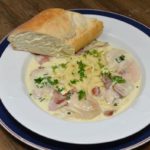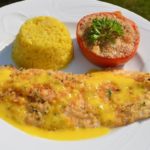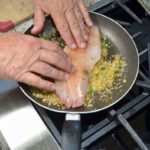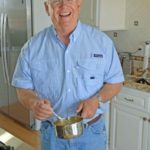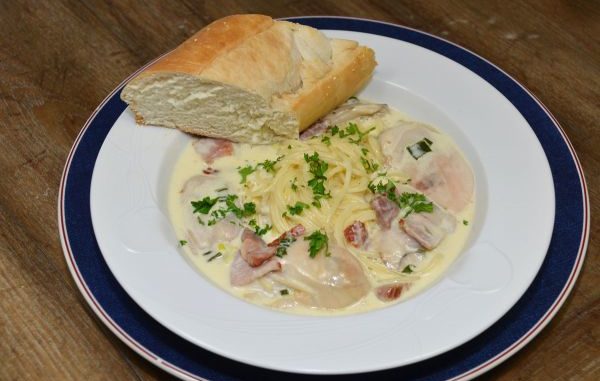
Bob Weiss is near-famous for his skill at catching big speckled trout. But virtually no one knows the youthful 70-year-old by his first name. Invariably, in the exclusive trophy trout circles he moves in, he is called “Doc Weiss.”
The retired Slidell physician has earned his speckled trout spurs in the last 15 years, since giving up South American peacock bass fishing and competitive largemouth bass fishing.
He’s always been a fishing addict. His flustered mother told him at an early age, “To like fishing is OK; you’re obsessed with it.”
Even fewer than know his first name, know he is a master chef.
“Fishing is a worse addiction,” he admitted, “but cooking is so much fun.”
Weiss’ cooking started with a divorce.
“I had five children, and had them every Wednesday and every other weekend. I couldn’t boil water,” he said. “Becky Adams, a med tech in my office, gave me a La Bouche Creole cookbook by Leon Soniat as a gift. The book started me cooking. It was so satisfying to do a dish and have my kids say, ‘Wow, that’s good!’
“During my 13 single years, I did a lot of experimenting, especially with seafood. I love all seafoods. My cooking is now Creole with French influences.”
Bob’s cooking skills were assisted by his friendship with one of his patients, Chris Kerageorgiou, the owner and chef of the famous La Provence restaurant (now owned by John Besh) in Lacombe.
“He called me ‘Bobba,’” Weiss chuckled. “We would have a cup of coffee and talk about everything in the world. He showed me how to do things — simple, but important things; things like stocks and sauces.
“I attended both of his cooking classes, and our friendship lasted until he died. He was a wonderful character.”
He’s brazen about learning from trained chefs.
“I’m not bashful about asking to go into restaurant kitchens,” Weiss said. “I strongly recommend asking for the chef. Nine times out of 10, they will ask you back into the kitchen and show you how to do stuff.
“You know what a good feeling is now? When your grown kids call you and ask for cooking advice.”
Oysters and Tasso in Cream-sauced Pasta
Bob credits famous Louisiana chef Paul Prudhomme for this dish.
“I cook this any time of the year, even though oysters are best in the winter,” he says. “It comes out good every time.
“The only seasoning in it the way I cook it is tasso — no salt or pepper. It’s a very simple recipe. It relies on the goodness of the ingredients. I think that it starts with the butter.
“Don’t overcook the oysters. If it comes back to a boil, they will shrink and be chewy and hard. Add the oysters, turn the fire off and cover it.”
Bob loves raw oysters, so the way he cooks them they are almost uncooked. If a more-cooked texture is desired, cook them until the edges of the oysters curl.
INGREDIENTS:
- 8 oz. thin spaghetti
- 1 1/2 sticks unsalted butter, divided
- 4 oz. tasso
- 4 green onions, chopped
- 1 pt. heavy whipping cream
- 1 qt. oysters, drained
- 2 sprigs parsley, chopped
PREPARATION:
Boil spaghetti in unsalted water, drain and set aside, covered. Cut the tasso into thin slices 1-inch in diameter. Melt 1 stick of butter in a frying pan. Add the tasso and sauté it over medium heat for 5 minutes. Add the green onions and sauté until the onions soften. Add the cream and cook, stirring frequently, until the cream thickens slightly. Add the remaining half-stick of butter and simmer until sauce becomes thick. Do not burn the sauce. Add the oysters, turn the heat off, cover and allow the dish to set for 5 minutes. Uncover and add enough cooked pasta to balance the pasta and the oysters. Adjust salt and pepper if necessary. Sprinkle chopped parsley over each serving after it is plated. Serve with French bread to sop up the cream sauce. Serves 4.
Oven-finished Panko Trout with Baked Tomatoes
“The idea for this recipe,” Bob said, “came from ShoeBooties Café, a North Carolina restaurant. When I ate it there, they prepared it with salmon. I went to the chef, and he gave me the recipe.
“He made it with a dill sauce. I prefer hollandaise sauce. I cook it once a month because my wife Merryl likes it.
INGREDIENTS:
- 4 ripe tomatoes, halved crossways
- Salt and pepper
- Parmesan cheese
- Italian bread crumbs
- 2 sticks of butter
- 1 tbsp. minced garlic
- 1 cup panko bread crumbs
- 1 1/2 tbsp. lemon zest
- 1 large sprig of parsley, minced
- 4 12-inch speckled trout fillets
- 4 egg yolks, divided
- 1 pinch cayenne pepper
- Juice of half a lemon
PREPARATION:
Place tomatoes, cut side up, in a baking pan. Salt and pepper them to taste. Add a layer of Parmesan cheese to taste, followed by a sprinkling of Italian bread crumbs to taste. Cut a half stick of butter into 8 pats and top each tomato half with a pat. Place pan in 350-degree oven and bake for 30 minutes.
Melt ½ stick butter in a frying pan. Add garlic and sauté over medium heat for 2 minutes. Add panko and stir until lightly browned. Add lemon zest and parsley and cook 3 minutes, stirring constantly. Turn heat off. Season both sides of the fish fillets with Creole seasoning to taste. Press fillets firmly into the breading mixture, one at a time and lay them, seasoned side up, in a baking pan. Do not bread the second side. Set the fillets aside to make the hollandaise sauce.
Cut remaining stick of butter into thirds. Melt 1/3 stick in a small sauce pan over low heat. Add 2 egg yolks and whisk the mixture constantly, moving the pan on and off of the burner. When blended, add another egg yolk and another 1/3 stick of butter. Repeat whisking process until blended, then add remaining egg yolk and butter, again whisking until blended. Do not allow the mixture to boil or the egg will set. Add a pinch of salt, a pinch of cayenne pepper and the lemon juice and whisk. Set the pan on the back of the stove to keep warm.
Bake breaded fish fillets in a 350-degree oven for 15 minutes. Plate the fillets and spoon the desired amount of hollandaise sauce over the fillets. There will be leftover sauce, which may be reserved for use elsewhere. Serve with baked tomatoes. Serves 4.
